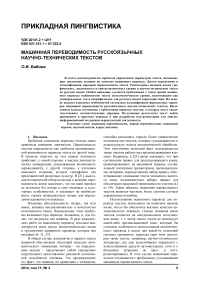Машинная переводимость русскоязычных научно-технических текстов
Автор: Бабина Ольга Ивановна
Журнал: Вестник Южно-Уральского государственного университета. Серия: Лингвистика @vestnik-susu-linguistics
Рубрика: Прикладная лингвистика
Статья в выпуске: 3 т.11, 2014 года.
Бесплатный доступ
В статье рассматривается проблема определения параметров текста, оказывающих негативное влияние на качество машинного перевода. Дается определение и классификация маркеров переводимости текста. Рассмотрены явления языка графического, лексического и синтагматического уровня в научно-техническом тексте на русском языке. Особое внимание уделяется проблемным с точки зрения машинного перевода особенностям текста синтагматического уровня, включающим как универсальные, так и специфические для русского языка характеристики. На основе анализа языковых особенностей составлена классификация формальных маркеров машинной переводимости русскоязычных научно-технических текстов. Выделенные классы соотнесены с проблемами перевода текстов, о которых могут свидетельствовать соответствующие маркеры. Полученные результаты могут найти применение в практике перевода и при разработке инструментария для лингвоинформационной поддержки переводческой деятельности.
Машинная переводимость, маркер переводимости, машинный перевод, научный текст, корпус текстов
Короткий адрес: https://sciup.org/147153914
IDR: 147153914 | УДК: 821.161.1
Список литературы Машинная переводимость русскоязычных научно-технических текстов
- Дрейфус Х. Чего не могут вычислительные машины: Критика искусственного разума. М.: Прогресс, 1978. 334 с.
- Шереметьева С.О. Интерактивное реферирование, ориентированной на машинный перевод. Вестник ЮУрГУ. Серия «Лингвистика». 2013. Т. № 1. С. 89-92.
- Allen J., Hogan C. Toward the Development of a Post-Editing Module for Raw Machine Translation Output: A Controlled Language Perspective, Proceedings of the Third International Workshop on Controlled Language Applications (Seattle, WA), 2000, pp. 62-71.
- Arnold D., Balkan L., Maijer L., Humphreys R. L., Sadler L. Machine Translation: An Introductory Guide, Oxford, NCC Blackwell, 1994, 206 p.
- Bergsma S., Yarowsky D., Church K. Using Large Monolingual and Bilingual Corpora to Improve Coordination Disambiguation, Proceedings of the 49th Annual Meeting of the Association for Computational Linguistics (Portland, Oregon), 2011, pp. 1346-1355.
- Bernth A., McCord M. The Effect of Source Analysis on Translation Confidence, J.S. White (ed.) Envisioning Machine Translation in the Information Future: 4th Conference of the Association for Machine Translation in the Americas (AMTA 2000) (Cuernavaca, Mexico), Berlin, Springer, 2000, pp. 89-99.
- Doyon J., Doran C., Means C. D., Parr D. Automated Machine Translation Improvement through Post-editing Techniques: Analyst and Translator Experiments, Proceedings of AMTA, 2008, pp. 346-353.
- Gdaniec C. The Logos Translatability Index, Technology Partnerships for Crossing the Language Barrier: Proceedings of the First Conference of the Association for Machine Translation in the Americas AMTA, Oct. 1994, pp. 97-105.
- Goldberg M. An Unsupervised Model for Statistically Determining Coordinate Phrase Attachment, Proceedings of ACL, 1999, pp. 610-614.
- Hartley A., Tatsumi M., Isahara H., Kageura K., Miyata R. Readability and Translatability Judgments for ‘Controlled Japanese’, Proceedings of the 16th EAMT Conference (Trento, Italy), May 2012, pp. 237-244.
- Hutchins W. J., Somers L. An Introduction to Machine Translation, London, Academic Press, 1992, 362 p.
- Kittredge R. Sublanguages and Controlled Language, R. Mitkov (ed.) The Oxford Handbook of Computational Linguistics, Oxford, OUP, 2003, pp. 430-447.
- Knight K., Chander I. Automated Post-Editing of Documents, Proceedings of the 12th National Conference on Artificial Intelligence (Seattle, WA), 1994, pp. 779-784.
- Marinčič D. Parding with Intraclausal Coordination and Clause Detection, Informatitica, 2010, no. 34, pp. 263-264.
- Nakov P., Hearst M. Using the Web as an Implicit Training Set: Application to Structural Ambiguity Resolution, Proceedings of HLT-EMNLP, 2005, pp. 835-842.
- Nyberg E., Mitamura T., Huijsen W.-O. Controlled Language for Authoring and Translation, H. Somers (ed.), Computers and Translation, Amsterdam, NL, Benjamins, 2003, pp. 245-281.
- O’Brien S. Methodologies for Measuring the Correlations between Post-Editing Effort and Machine Translatability, Machine Translation, 2005, no. 19, pp. 37-58.
- O'Brien S. Controlling Controlled English: An Analysis of Several Controlled Language Rule Sets, Joint conference combining the 8th International Workshop of the European Association for Machine Translation and the 4th Controlled Language Applications Workshop (EAMT/CLAW)(Dublin City University), May 2003, pp. 105-114.
- Okuma H., Hara K., Shimbo M., Matsumoto Y. Bypassed Alignment Graph for Learning Coordination in Japanese Sentences, Proceedings of the ACL-IJCNLP 2009: Conference Short Papers (Suntec, Singapore), Aug. 2009, pp. 5-8.
- Okumura A., Muraki K. Symmetric Pattern Matching Analysis for English Coordinate Structures, Proceedings of the fourth conference on Applied Natural Language Processing (ANLP), 1994, pp. 41-46.
- Pedro R. de. The Translatability of Texts: A Historical Overview, Meta, 1999, Vol. XLIV, no. 4, pp. 546-559.
- Povlsen C., Underwood N., Music B., Neville A. Evaluating Text-type Suitability for Machine Translation a Case Study on an English-Danish MT System, A. Rubio, N. Gallardo, R. Castro & A. Tejada (eds.) Proceedings of the First International Conference on Language Resources and Evaluation (Granada, Spain), 1998, vol. 1, pp. 27-31.
- Reuther U. Two in one -Can it work? Readability and Translatability by means of Controlled Language, Proceedings of EAMT-CLAW03, Controlled Language Translation (Dublin City University, Dublin), May2003, pp. 124-132.
- Roh Y.-H., Lee K.-Y., Choi S.-K., Kwon Oh-W., Kim Y.-G. Recognizing Coordinate Structures for Machine Translation of English Patent Documents, Proceedings of the 22nd Pacific Asia Conference on Language, Information and Computation (De La Salle University, Manila, Philippines), Nov. 2008, pp. 460-466.
- Roh Y.-H., Seo Y.-A., Lee K.-Y., Choi S.-K. Long Sentence Partitioning using Structure Analysis for Machine Translation, Proceedings of the Sixth Natural Language Processing Pacific Rim Symposium (Hitotsubashi Memorial Hall, National Center of Sciences, Tokyo, Japan), Nov. 2001, pp. 646-652.
- Sheremetyeva S. Handling Low Translatability in Machine Translation, Proceedings of the Eleventh Conference of European Association of Machine Translation (EAMT)(Oslo, Norway), June 2006, pp. 105-114.
- Trujillo A. Translation Engines: Techniques for Machine Translation, London, Sptringer-Verlag, 1999, 303 p.
- Underwood N. L., Jongejan B. Translatability Checker: A Tool to Help Decide Whether to Use MT, B. Maegaard (ed.), Proceedings of MT Summit VIII (Santiago de Compostela, Galicia, Spain), Sept. 2001, pp. 363-368.


